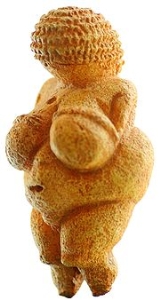
Venus of Willendorf
Overview
The Venus of Willendorf, also known as the Woman of Willendorf, is an 11 cm (4.3 in) high statue
tte of a female figure estimated to have been made between 24,000 and 22,000 BCE. It was discovered in 1908 by archaeologist Josef Szombathy
at a paleolithic
site near Willendorf
, a village in Lower Austria
near the city of Krems. It is carved from an oolitic
limestone
that is not local to the area, and tinted with red ochre. The "Venus of Willendorf" is now in the Naturhistorisches Museum
in Vienna
.
Several similar statuettes and other forms of art have been discovered, and they are collectively referred to as Venus figurines
, although they pre-date the mythological figure of Venus
by millennia.
Statue
A statue is a sculpture in the round representing a person or persons, an animal, an idea or an event, normally full-length, as opposed to a bust, and at least close to life-size, or larger...
tte of a female figure estimated to have been made between 24,000 and 22,000 BCE. It was discovered in 1908 by archaeologist Josef Szombathy
Josef Szombathy
Josef Szombathy , was an Austrian archaeologist, who found the Venus of Willendorf in 1908.The Venus of Willendorf is an 11.1 cm high statuette of a female figure, discovered at a paleolithic site near Willendorf, a village in Lower Austria near the city of Krems...
at a paleolithic
Paleolithic
The Paleolithic Age, Era or Period, is a prehistoric period of human history distinguished by the development of the most primitive stone tools discovered , and covers roughly 99% of human technological prehistory...
site near Willendorf
Aggsbach
Aggsbach is a small wine-growing town in the Krems-Land district of Lower Austria, Austria. As of 2001, it has a population of 714 and an area of 13.72 km.²...
, a village in Lower Austria
Lower Austria
Lower Austria is the northeasternmost state of the nine states in Austria. The capital of Lower Austria since 1986 is Sankt Pölten, the most recently designated capital town in Austria. The capital of Lower Austria had formerly been Vienna, even though Vienna is not officially part of Lower Austria...
near the city of Krems. It is carved from an oolitic
Oolite
Oolite is a sedimentary rock formed from ooids, spherical grains composed of concentric layers. The name derives from the Hellenic word òoion for egg. Strictly, oolites consist of ooids of diameter 0.25–2 mm; rocks composed of ooids larger than 2 mm are called pisolites...
limestone
Limestone
Limestone is a sedimentary rock composed largely of the minerals calcite and aragonite, which are different crystal forms of calcium carbonate . Many limestones are composed from skeletal fragments of marine organisms such as coral or foraminifera....
that is not local to the area, and tinted with red ochre. The "Venus of Willendorf" is now in the Naturhistorisches Museum
Naturhistorisches Museum
The Naturhistorisches Museum Wien or NHMW is a large museum located in Vienna, Austria.The collections displayed cover , and the museum has a website providing an overview as a video virtual tour....
in Vienna
Vienna
Vienna is the capital and largest city of the Republic of Austria and one of the nine states of Austria. Vienna is Austria's primary city, with a population of about 1.723 million , and is by far the largest city in Austria, as well as its cultural, economic, and political centre...
.
Several similar statuettes and other forms of art have been discovered, and they are collectively referred to as Venus figurines
Venus figurines
Venus figurines is an umbrella term for a number of prehistoric statuettes of women portrayed with similar physical attributes from the Upper Palaeolithic, mostly found in Europe, but with finds as far east as Irkutsk Oblast, Siberia, extending their distribution to much of Eurasia, from the...
, although they pre-date the mythological figure of Venus
Venus (mythology)
Venus is a Roman goddess principally associated with love, beauty, sex,sexual seduction and fertility, who played a key role in many Roman religious festivals and myths...
by millennia.
Discussions

